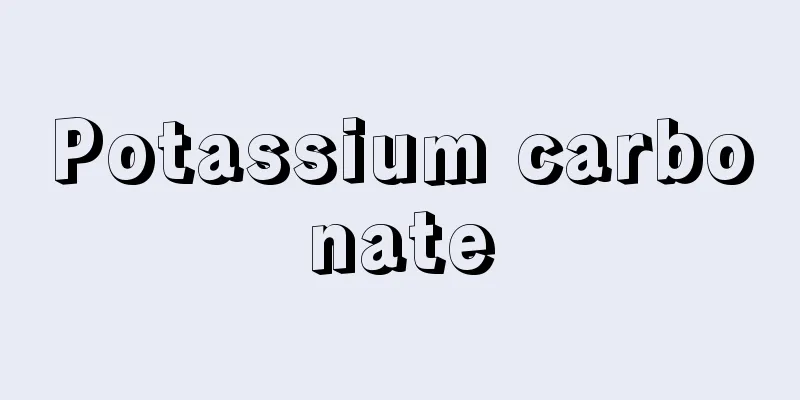Fatty acid - Shibosan (English spelling)

|
A chain-type carboxylic acid with one carboxyl group (carboxyl group)-COOH. It is so named because it is obtained by hydrolysis of fats. In nature, it is widely distributed in animals and plants as esters of glycerin or higher monohydric alcohols, but there are very few cases where fatty acids themselves exist in a free state. Glycerin esters of fatty acids are fats, and higher monohydric alcohol esters are waxes. The majority of fatty acids present in living organisms have a structure in which an even number of carbon atoms are bonded in a straight chain. Fatty acids are classified into saturated fatty acids, in which all carbon atoms are saturated and have the general formula C n H 2n+1 COOH, and unsaturated fatty acids, which have double or triple bonds in the chain. For synthesis methods, see the "Carboxylic Acid" entry. [Masahiro Hirota] natureSaturated fatty acids with a low carbon number are colorless liquids, while higher saturated fatty acids with 10 or more carbons are colorless solids. Unsaturated fatty acids have different melting points depending on the length of the carbon chain and the position of the multiple bonds (unsaturated bonds), but most exist as colorless liquids or low-melting solids. Carboxylic acids with a low carbon number, such as formic acid and acetic acid, have a pungent odor and are highly soluble in water, but carboxylic acids with around 6 carbons have an unpleasant putrid odor and are only slightly soluble in water. Higher fatty acids with a carbon chain of 10 or more are almost odorless and insoluble in water. They are highly soluble in solvents such as ethanol (ethyl alcohol), chloroform, and ether. When dissolved in water, the hydrogen in the carboxyl group dissociates as a hydroxonium ion (hydrogen ion), indicating acidity. However, dissociation only occurs partially, making them weak acids. [Masahiro Hirota] ApplicationsSodium salts of saturated higher fatty acids such as palmitic acid and stearic acid, which are components of fats and oils, are used as soap. In addition, acetic acid is widely used in vinegar, synthetic raw materials, solvents, etc. With the exception of acetic acid, fatty acids are rarely consumed in their free form in food, but they are important as an energy source in animal bodies. When fat is absorbed as fatty acids from the intestinal tract, it returns to fat form and is stored subcutaneously, and when needed, it becomes fatty acids and is broken down in the liver. As a nutrient, it has a high calorie value. Since most animals cannot synthesize linoleic acid and linolenic acid in their bodies, these fatty acids have been called vitamin F. There are various theories regarding the amount of linoleic acid that humans should consume, but 15 to 25 grams of linoleic acid per day is sufficient. Some are of the opinion that excessive intake should be avoided. [Masahiro Hirota] DerivativesGlycerides, esters of fatty acids and glycerin, are widely distributed as fats and oils throughout the animal and plant kingdoms. Glycerides of saturated fatty acids are white solids and are the main components of animal fats such as beef tallow, while glycerides of unsaturated fatty acids such as oleic acid and linoleic acid are liquid and found in large amounts in vegetable oils and fish oils. Esters of lower fatty acids and lower monohydric alcohols generally have an aromatic scent, and many of them are known as aromatic components of fruits. Metal salts of higher fatty acids are generally called soaps. Fat soaps, which are used in baths, are fatty acid sodium salts. [Masahiro Hirota] Fatty acids in the bodyIn the body, fatty acids are broken down and synthesized through the fatty acid cycle. This cycle breaks down and synthesizes fatty acids in units of two carbon atoms, which is why most naturally occurring fatty acids have an even number of carbon atoms. Unsaturated fatty acids are thought to be synthesized by the action of enzymes that create unsaturated double bonds. Animals lack the enzymes to synthesize linoleic acid and linolenic acid, so these fatty acids are essential fatty acids that must be replenished by eating plants. A deficiency of linoleic acid and linolenic acid can lead to growth inhibition, skin and kidney disorders, and reduced fertility. This is due to a decrease in prostaglandins, important physiologically active substances synthesized via linoleic acid, linolenic acid, and arachidonic acid. Fatty acids are important nutrients, and are stored in the body as fat and are oxidatively broken down in the liver as needed. The amount of energy and water released during this process is about twice as much as nutrients such as carbohydrates and proteins, so animal nutrition is mainly in the form of fat or fatty acids. Fatty acids are one of the basic components of biological membranes, and are mainly in the form of glycerophospholipids, which account for more than 70% of phospholipids. The types of fatty acids that compose this are thought to determine the membrane's permeability, fluidity, and adaptability to the outside world. [Takayoshi Wakagi] FoodAlmost all fatty acids in food fats are straight-chain saturated and unsaturated fatty acids with an even number of carbon atoms. The carbon numbers vary widely, but palmitic acid with 16 carbon atoms, and oleic and linoleic acids with 18 carbon atoms are the major ones. There are also oils and fats with unique compositions, such as milk fat (short-chain fatty acids with 4 and 6 carbon atoms), coconut oil, palm kernel oil (medium-chain fatty acids with 8 to 12 carbon atoms), and whale oil (polyunsaturated fatty acids with 20 and 22 carbon atoms). Rapeseed oil is characterized by its erucic acid (erucic acid), but it has become almost nonexistent due to breeding. In general, edible vegetable oils are rich in linoleic acid, while terrestrial animal oils and fats are rich in saturated fatty acids. Reflecting differences in fatty acid composition, fats and oils are solid (fats) or liquid (oils) at room temperature. Fatty acids are also related to the taste of food, and a high degree of unsaturation seems to give food a richer taste (e.g., eel). Short-chain fatty acids, especially butyric acid, can cause bad odors when liberated by hydrolysis of fats and oils. Fatty acids are the most efficient energy source in animals and are stored as triglycerides. Saturated fatty acids are stable, but unsaturated fatty acids are easily oxidized. Lipid peroxides are the cause of aging, cancer, arteriosclerosis, etc. Natural unsaturated fatty acids have cis-type double bonds, and essential fatty acids can only function when all double bonds are cis-type. In the hydrogenation process of fats and oils, trans-type (geometric isomer of cis-type) unsaturated fatty acids, which are rare in nature, are produced. Trans-type fatty acids are mainly contained in margarine and shortening as monounsaturated acids (e.g. elaidic acid). Trans-type fatty acids are absorbed to almost the same extent as saturated fatty acids and used as an energy source, but if consumed in large quantities, they can increase the demand for essential fatty acids, interfere with cis-type acid metabolism, inhibit prostaglandin synthesis, and increase serum cholesterol levels. However, these effects are negligible within the range of daily intake (2 grams or less). [Michihiro Kanno] "Organic Chemistry, Volumes 1 and 2, by Nozoe Tetsuo (1970, 1972, Hirokawa Shoten)" ▽ "General Lipid Chemistry, edited by Kayama Hikaru (1989, Koseisha Kouseikaku)" ▽ "The Science of Lipids, edited by Nakamura Haruo (1990, Asakura Shoten)" ▽ "Experimental Chemistry Course: Organic Synthesis 4, Acids, Amino Acids, and Peptides, edited by the Chemical Society of Japan (1992, Maruzen)" ▽ "New Biochemistry Experiment Course 4, Lipids 1, Neutral Lipids and Lipoproteins, edited by the Japanese Biochemical Society (1993, Tokyo Kagaku Dojin)" ▽ "Lipids and Steroids: Techniques for Tissue and Cell Chemistry, edited by Ogawa Kazuo et al. (1993 , Asakura Shoten)" ▽ "Morrison-Boyd Organic Chemistry (Volumes 1, 2, and 3), 6th edition, by Robert Thornton Morrison and Robert Neilson Boyd, translated by Nakanishi Koji et al. (1994, Tokyo Kagaku Dojin)" ▽ "Structural Analysis of Natural Organic Compounds - Methods for Determining Structure by Instrumental Analysis" by Nobuhiro Fushiya, Hiroshi Hirota, et al. (1994, Springer-Verlag Tokyo)" ▽ "AA, EPA, DHA - Highly Unsaturated Fatty Acids" edited by Hikasa Kayama (1995, Koseisha Koseisha)" ▽ "Introduction to Oil and Fat Chemistry - From Basics to Applications" by Tomihiro Kurosaki and Kazuhisa Yagi (1995, Sangyo Tosho)" ▽ "Standard Biochemistry" by Fumio Arisaka (1996, Shokabo)" ▽ "Introduction to Molecular Nutrition" edited by Takehiko Tanaka et al. (1996, Kenpakusha) " ▽ "Brain Function and Lipids" edited by Harumi Okuyama and Susumu Ando (1997, Kansai Society Center), supervised by the Japanese Society of Lipid Nutrition" ▽ "Fatty Acids and Health, Lifestyle, and Environment - From DHA to Royal Jelly" by Kunimitsu Kagaya (1997, Shokabo) ▽ "Bioseparation Engineering" by Nakanishi Kazuhiro et al. (1997, Kodansha) " ▽ "Japanese Food Composition Tables -- Fourth, Follow-up and Fifth Editions (New Foods) Complete Listing of Ingredients" edited by the Science and Technology Agency Resources Survey Committee , supervised by Yamaguchi Michio (1997, Ishiyaku Shuppan)" ▽ "Lipid Nutrition and Lipid Peroxidation -- Is In vivo Lipid Peroxidation Damaging or Defense?" edited by Okuyama Harumi and Kikugawa Kiyomi (1998, Kansai Society Center)" ▽ "Modern Perspectives on Fatty Acid Nutrition" edited by Igarashi Osamu and Kanno Michihiro (1998, Koseikan)" ▽ "Introduction to Biology for Semesters" by Nagai Akira and Ueno Shinpei (1998, Tokai University Press)" ▽ "Development of Functional Lipids" edited by Sato Kiyotaka et al. (1999, CMC)" ▽ "The Body Rusts - Lifestyle-Related Diseases Caused by Enzyme Stress," edited by the Pharmaceutical Society of Japan and written by Kikukawa Kiyomi (1999, Maruzen)" ▽ "The Processing Characteristics and Physiological Functions of Soy Protein," edited by the Japanese Society of Nutrition and Food Science and edited by Kanno Michihiro and Takashi Hiroko (1999, Kenpakusha)" ▽ "The Latest Information on Lipid Research - Considering Appropriate Intake," written by Kanno Michihiro et al. (2000, Daiichi Publishing)" ▽ "Physiologically Active Lipids - Biochemistry and Applications of Short-Chain Fatty Acids," written by Hara Kenji (2000, Saiwai Shobo)" ▽ "McMurry's Organic Chemistry (Vol. 1, 2, and 3), 5th Edition, written by John McMurry and translated by Ito Sho et al. (2001, Tokyo Kagaku Dojin)" ▽ "Oil Chemistry Handbook - Lipids and Surfactants," edited by the Japan Oil Chemists' Society (2001, Maruzen)" ▽ "Natural Products Chemistry," edited by Tanaka Osamu et al. (2002, Nanzando)" [References] | | | | | | | | | | | | | | | | | | | | | | | | | | | | | | |butyric | | | |Source: Shogakukan Encyclopedia Nipponica About Encyclopedia Nipponica Information | Legend |
|
カルボキシ基(カルボキシル基)-COOH1個をもつ鎖式のカルボン酸をいう。脂肪を加水分解すると得られるのでこの名がある。天然には、グリセリンや高級一価アルコールのエステルとして広く動植物体内に分布しているが、脂肪酸そのものが遊離して存在する例はきわめて少ない。脂肪酸のグリセリンエステルが脂肪であり、高級一価アルコールエステルが蝋(ろう)である。生物体中に存在する脂肪酸の大部分は、偶数個の炭素が直鎖状に結合した構造をもつ。脂肪酸は、すべての炭素原子が飽和していてCnH2n+1COOHの一般式で示される飽和脂肪酸と、鎖に二重結合や三重結合をもつ不飽和脂肪酸に分類される。合成法は「カルボン酸」の項を参照のこと。 [廣田 穰] 性質飽和脂肪酸では、炭素数が少ない低級のものは無色の液体であるが、炭素数が10以上の高級飽和脂肪酸は無色の固体である。不飽和脂肪酸は、炭素鎖の長さや多重結合(不飽和結合)の位置により融点が異なるが、多くは無色の液体ないしは低融点の固体として存在する。ギ酸、酢酸などの炭素数が少ないカルボン酸は刺激臭をもち、水によく溶けるが、炭素数6前後のカルボン酸は不快な腐敗臭をもっていて、水にはわずかに溶けるだけである。炭素鎖が10以上の高級脂肪酸はほとんど無臭で水に溶けない。エタノール(エチルアルコール)、クロロホルム、エーテルなどの溶媒にはいずれもよく溶ける。カルボキシ基の水素は水に溶かすとヒドロキソニウムイオン(水素イオン)として解離するので酸性を示す。しかし、解離は部分的にしかおこらないので弱い酸である。 [廣田 穰] 用途油脂の成分となっているパルミチン酸、ステアリン酸などの飽和高級脂肪酸のナトリウム塩はせっけんとして使われている。このほかに、酢酸は食酢、合成原料、溶剤などに広く使われている。 脂肪酸を遊離の形で食品とすることは酢酸を除いてほとんどないが、動物体内におけるエネルギー源として重要である。脂肪が腸管から脂肪酸として吸収されると、ふたたび脂肪の形に戻って皮下に貯蔵され、必要に応じて脂肪酸となり肝臓で分解される。栄養素として高いカロリー値をもっている。動物の多くはリノール酸、リノレン酸の合成を体内で行えないので、これらの脂肪酸はビタミンFとよばれたことがある。ヒトの摂取量については諸説があるが、リノール酸を1日15~25グラム摂取すれば十分である。過剰の摂取は避けるべきとの意見もある。 [廣田 穰] 誘導体脂肪酸とグリセリンのエステルであるグリセリドは油脂として広く動植物界に分布している。飽和脂肪酸のグリセリドは白色の固体で牛脂などの動物脂肪の主成分であるが、不飽和脂肪酸であるオレイン酸、リノール酸などのグリセリドは液体で植物油、魚油などに多く含まれている。低級脂肪酸と低級一価のアルコールのエステルは一般に芳香を有し、果実の芳香成分として知られているものが多い。高級脂肪酸の金属塩を一般にせっけんという。化粧せっけんとよばれて浴用などに用いられているのは脂肪酸ナトリウム塩である。 [廣田 穰] 生体内の脂肪酸生体内で脂肪酸は、脂肪酸回路によって分解されたり、合成されたりする。この回路は、炭素数二つずつの単位で脂肪酸の合成や分解を行うので、天然に存在するほとんどの脂肪酸の炭素数が偶数となるのである。不飽和脂肪酸は、不飽和二重結合をつくる酵素の働きで合成されると思われる。 動物には、リノール酸やリノレン酸を合成する酵素がないため、これらの脂肪酸は、植物を食べて補給されなければならない必須脂肪酸(ひっすしぼうさん)である。リノール酸やリノレン酸が欠乏すれば、成長阻害、皮膚や腎臓(じんぞう)の障害、受精能力の減退を招く。これは、リノール酸、リノレン酸、アラキドン酸を経て合成される重要な生理活性物質プロスタグランジンの減少による。 脂肪酸は栄養素として重要であり、脂肪として体内に蓄えられ、必要に応じて肝臓で酸化的に分解される。このとき発生するエネルギーや水の量は、炭水化物やタンパク質などの栄養素と比較して約2倍なので、動物の栄養貯蔵は主として脂肪ないし脂肪酸の形をとる。 脂肪酸は、生体膜の基本的な構成成分の一つで、主としてリン脂質の70%以上を占めているグリセロリン脂質の形態をとっている。これを構成する脂肪酸の種類によって、膜の透過性、流動性、外界への適応などが左右されると考えられる。 [若木高善] 食品食品中の脂質に含まれる脂肪酸のほとんどすべては炭素数偶数個で直鎖の飽和および不飽和脂肪酸である。炭素数はきわめて広範囲に及ぶが、量的には炭素数16のパルミチン酸、炭素数18のオレイン酸およびリノール酸が主要なものである。牛乳脂肪(炭素数4、6の短鎖脂肪酸)、やし油、パーム核油(炭素数8~12の中鎖脂肪酸)や魚鯨油(炭素数20、22の多価不飽和脂肪酸)のように独特な組成の油脂もある。菜種油はエルシン酸(エルカ酸)を含むことで特徴づけられるが、品種改良によりほとんど含まれなくなっている。一般に食用植物油脂はリノール酸に富み、陸産動物油脂は飽和脂肪酸が多い。 脂肪酸組成の違いを反映して、油脂は常温において固体状(脂)あるいは液体状(油)を呈する。脂肪酸は食品の食味とも関係し、不飽和度が高くなると濃厚な味を与えるようである(たとえばウナギ)。短鎖脂肪酸、とくに酪酸が油脂の加水分解によって遊離すると悪臭の原因となる。 脂肪酸は動物体内のエネルギー源としてもっとも効率的な成分であり、トリグリセリドとして貯蔵される。飽和脂肪酸は安定であるが、不飽和脂肪酸は酸化されやすい。脂質過酸化物は老化、癌(がん)、動脈硬化などの原因となる。天然の不飽和脂肪酸の二重結合はシス型であり、必須脂肪酸はすべての二重結合がシス型のときのみその機能を発現する。油脂の水素添加過程で、天然には稀(まれ)であるトランス型(シス型の幾何異性体)不飽和脂肪酸が生成する。トランス酸は主としてモノ不飽和酸(たとえばエライジン酸)としてマーガリン、ショートニング中に含まれる。トランス酸は飽和脂肪酸とほぼ同程度吸収されエネルギー源として利用されるが、多量摂取すると必須脂肪酸要求量の増加、シス酸代謝の妨害やプロスタグランジン合成の抑制、血清コレステロール濃度の上昇などを引き起こす。しかし、日常摂取量(2グラム以下)の範囲ではこのような影響は無視できる。 [菅野道廣] 『野副鐵男著『有機化学』上下(1970、1972・廣川書店)』▽『鹿山光編『総合脂質化学』(1989・恒星社厚生閣)』▽『中村治雄編『脂質の科学』(1990・朝倉書店)』▽『日本化学会編『実験化学講座 有機合成4 酸・アミノ酸・ペプチド』(1992・丸善)』▽『日本生化学会編『新 生化学実験講座4 脂質1 中性脂質とリポタンパク質』(1993・東京化学同人)』▽『小川和朗他編『脂質とステロイド――組織細胞化学の技術』(1993・朝倉書店)』▽『ロバート・ソーントン・モリソン、ロバート・ニールソン・ボイド著、中西香爾他訳『モリソン・ボイド有機化学(上中下)』第6版(1994・東京化学同人)』▽『伏谷伸宏・広田洋他著『天然有機化合物の構造解析――機器分析による構造決定法』(1994・シュプリンガー・フェアラーク東京)』▽『鹿山光編『AA、EPA、DHA――高度不飽和脂肪酸』(1995・恒星社厚生閣)』▽『黒崎富裕・八木和久著『油脂化学入門――基礎から応用まで』(1995・産業図書)』▽『有坂文雄著『スタンダード 生化学』(1996・裳華房)』▽『田中武彦他責任編集『分子栄養学概論』(1996・建帛社)』▽『日本脂質栄養学会監修、奥山治美・安藤進編『脳の働きと脂質』(1997・学会センター関西)』▽『彼谷邦光著『脂肪酸と健康・生活・環境――DHAからローヤルゼリーまで』(1997・裳華房)』▽『中西一弘他著『生物分離工学』(1997・講談社)』▽『山口迪夫監修、科学技術庁資源調査会編『日本食品成分表――四訂・フォローアップ・五訂(新規食品)成分完全収載』(1997・医歯薬出版)』▽『日本脂質栄養学会監修、奥山治美・菊川清見編『脂質栄養と脂質過酸化――生体内脂質過酸化は傷害か防御か』(1998・学会センター関西)』▽『日本栄養・食糧学会監修、五十嵐脩・菅野道廣編『脂肪酸栄養の現代的視点』(1998・光生館)』▽『永井彰・上野信平著『セメスター対応 生物学入門』(1998・東海大学出版会)』▽『佐藤清隆他監修『機能性脂質の開発』(1999・シーエムシー)』▽『日本薬学会編、菊川清見著『からだが錆びる――酵素ストレスによる生活習慣病』(1999・丸善)』▽『日本栄養・食糧学会監修、菅野道廣・尚弘子責任編集『大豆タンパク質の加工特性と生理機能』(1999・建帛社)』▽『菅野道廣他著『脂質研究の最新情報――適正摂取を考える』(2000・第一出版)』▽『原健次著『生理活性脂質――短鎖脂肪酸の生化学と応用』(2000・幸書房)』▽『ジョン・マクマリー著、伊東椒他訳『マクマリー有機化学(上中下)』第5版(2001・東京化学同人)』▽『日本油化学会編『油化学便覧――脂質・界面活性剤』(2001・丸善)』▽『田中治他編『天然物化学』(2002・南江堂)』 [参照項目] | | | | | | | | | | | | | | | | | | | | | | | | | | | | | | | | | | | |出典 小学館 日本大百科全書(ニッポニカ)日本大百科全書(ニッポニカ)について 情報 | 凡例 |
<<: Fatty acid oxidation pathway
Recommend
Kamojima [town] - Kamojima
A former town in Oe County in northern Tokushima P...
Gantillon, S.
...Compared to the new plays (J. Renard, Courtrin...
Rikubansui
A city in the western part of Guizhou Province, Ch...
Elisabeth (Holy Family) Elisabeth
…In artistic representations, various episodes fr...
publica fides (English spelling) publicafides
…Notaries are appointed by the Minister of Justic...
Italian Movies - Italian Movies
Italy's film production industry developed af...
Red-legged planthopper - Red-legged planthopper
...It is distributed in Honshu, Shikoku, and Kyus...
Whisker - Whisker
Please see the "Beard Crystal" page. So...
Parenzo
…Ancient name: Parentium. Until 1947 it was part ...
Arechikamadori - Arechikamadori
...They live on trees and build nests in trees us...
Grassroots Magazine - Soumou Zasshi
This was a political commentary magazine in the ea...
Mousebird (Japanese mousebird)
A general term for birds in the family Coliidae (o...
Kinh
…In Chinese characters, they are written as Yuen ...
natürliche Verbindlichkeit (English notation) naturliche Verbindlichkeit
...In addition, in early Roman law, it was said t...
guard
〘noun〙 (guard)① To guard. To protect or defend. Al...








![Kibi [town] - Kibi](/upload/images/67cb563a68e3e.webp)
